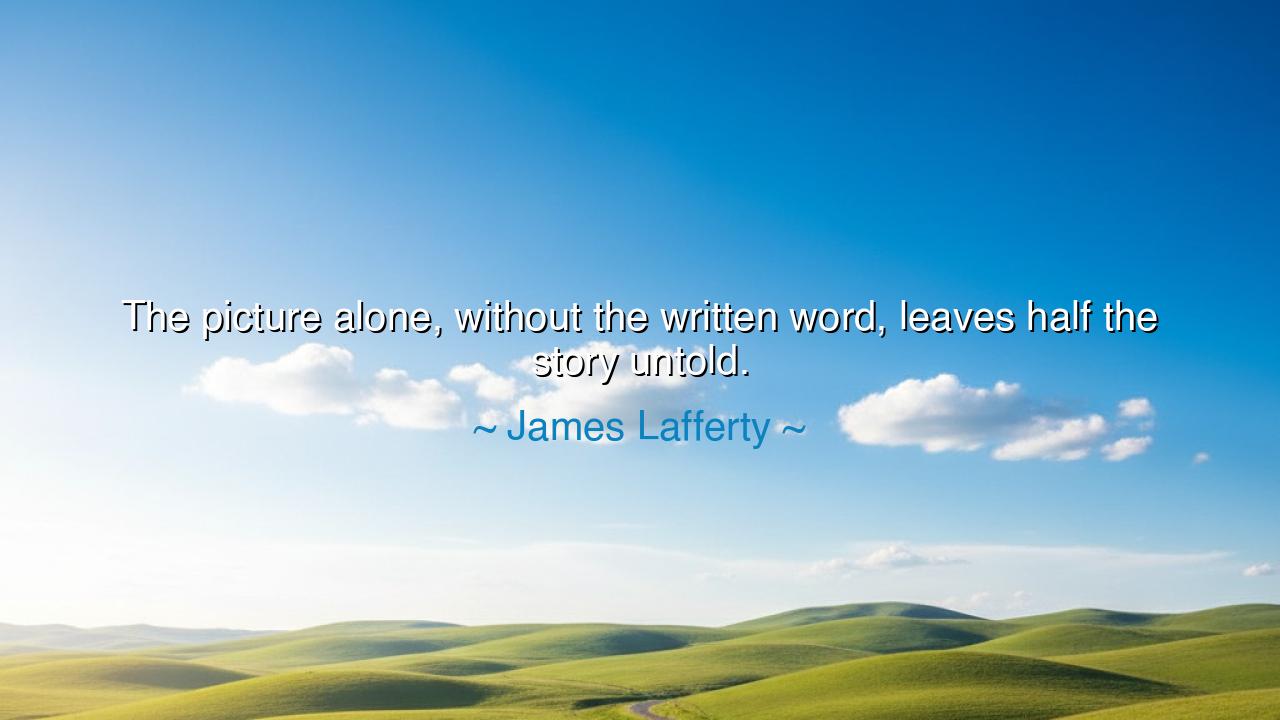
The picture alone, without the written word, leaves half the






"The picture alone, without the written word, leaves half the story untold." These profound words by James Lafferty carry within them a timeless truth about the nature of communication and the deeper layers of meaning that are often hidden beneath the surface of what we see. A picture, in its silence, may capture a moment, a feeling, or a scene, but it is only through the written word that the full weight of the story comes to life. The image speaks, but it is the words that give it context, purpose, and depth. Without the story, the picture is but a fragment, a single note without the symphony that gives it meaning.
Consider, for a moment, the ancient storytellers who wove their tales not only with images but with words. In their epics, from the Iliad of Homer to the Mahabharata of India, it was not enough to merely depict the gods and heroes in battle. Words were used to illuminate the souls of the characters, to explain their motivations, their triumphs, and their fallibilities. A picture of a warrior might show him in his finest hour, but only the words could reveal the inner conflict that drove him to that moment, the struggles that defined his journey. The image without the story is a shadow, but with the words, it becomes a full revelation of the human experience.
This is the very essence of Lafferty’s insight: the visual world we live in is incomplete without the stories we tell. Take, for instance, the art of war—a battlefield scene may be a striking display of chaos, courage, and bloodshed, but it is the narrative of why the battle was fought, who the warriors were, and what the stakes were, that transforms it from mere violence into a lesson about human ambition, fate, and sacrifice. Without the written word to carry the deeper meaning, the picture remains a vivid but empty portrayal of surface events.
In a modern context, consider the photographs of war that have moved the hearts of millions. Robert Capa's iconic image of a soldier in the Spanish Civil War, falling amidst the chaos of battle, is one of the most powerful war photographs ever taken. Yet, without the story behind the image, the viewer might merely see an action frozen in time—a snapshot of violence. But with the context of the war, the personal story of the soldier, and the political backdrop of the conflict, the image becomes a testament to sacrifice, a grief-stricken reminder of the cost of war. The words behind the image allow it to transcend its initial shock, transforming it into a profound statement on humanity.
Yet, in all this, we must understand that the written word does not exist in opposition to the visual—it complements it. A story told through words can paint pictures in the mind that no camera can capture, and a picture can evoke feelings and emotions that words may struggle to express. Together, they create a full narrative—a tapestry woven from both the visible and the invisible threads of life. This duality is what makes both the visual and the written word powerful tools for communication. Alone, each is incomplete, but together they offer a holistic understanding of the world.
From this, the lesson is clear: context is everything. In our lives, as in stories, it is the combination of experiences—the seen and the unseen, the spoken and the silent—that gives our world its full meaning. The visual world we encounter each day is rich with potential stories, but it is through the stories we tell, the words we speak, that we bring those moments to life. The image without the context is like a song without melody, a journey without a destination.
Therefore, as we walk through life, let us not merely take in the images that pass before our eyes but seek the story behind them. In our relationships, in our work, in our passions, we must remember that the full story is often hidden beneath the surface, and it is our responsibility to dig deeper, to ask the questions that uncover the hidden truths. By doing so, we enrich not only our understanding of the world but also the lives we lead. Let us be both observers and storytellers, recognizing that the true essence of life is found in the blend of sight and narrative, of the visible and the invisible.






AAdministratorAdministrator
Welcome, honored guests. Please leave a comment, we will respond soon